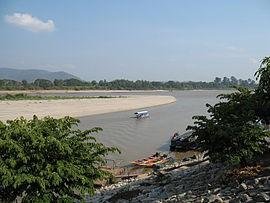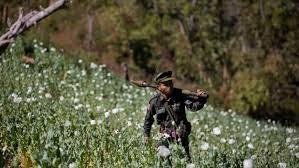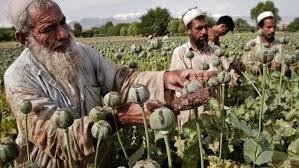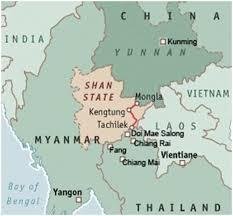Myanmar drug trafficking
Myanmar has burned an estimated $385m (£300m) worth of illegal drugs, to mark the UN day against drug abuse and trafficking.
The burning, which happened at an elaborate ceremony, comes as law enforcement agencies struggle to curb the flow of drugs across southeast Asia.
Myanmar remains one of the world's biggest opium producers.
The Golden Triangle (Burmese: ရွှေတြိဂံ နယ်မြေ, IPA: [ʃwè tɹḭɡàɴ nɛ̀mjè]; Thai: สามเหลี่ยมทองคำ, IPA: [sǎːm.lìəm.tʰɔːŋ.kʰam]; Lao: ສາມຫຼ່ຽມທອງຄຳ; Vietnamese: Tam giác Vàng; Khmer: តំបន់ត្រីកោណមាស, Khmer pronunciation: [tɑmbɑn trəy kaon mieh]) is one of Asia's two main opium-producing areas. It is an area of approximately 950,000 square kilometres (367,000 sq mi) that overlaps the mountains of three countries of Southeast Asia: Myanmar, Laos and Thailand.
Along with Afghanistan in the Golden Crescent, it has been one of the most extensive opium-producing areas of Asia, and of the world, since the 1950s. Most of the world's heroin came from the Golden Triangle until the early 21st century when Afghanistan became the world's largest producer.
The Golden Triangle designates the confluence of the Ruak River and the Mekong River, since the term has been appropriated by the Thai tourist industry to describe the nearby border tripoint of Thailand, Laos and Myanmar.

Myanmar is the world's second largest producer of illicit opium, after Afghanistan and has been a significant cog in the transnational drug trade since World War II. According to the UNODC it is estimated that in 2005 there wеrе 430 square kilometres (167 sq mi) of opium cultivation in Myanmar. 

The surrender of drug warlord Khun Sa's Mong Tai Army in January 1996 was hailed by Yangon as a major counter-narcotics success. Lack of government will and agility to take on major narcotrafficking groups and lack of serious commitment against money laundering continues to hinder the overall anti-drug effort. Most of the tribespeople growing the opium poppy in Myanmar and in the Thai highlands are living below the poverty line.
In 1996, the United States Embassy in Rangoon released a "Country Commercial Guide", which states "Exports of opiates alone appear to be worth about as much as all legal exports." It goes on to say that investments in infrastructure and hotels are coming from major opiate-growing and opiate-exporting organizations and from those with close ties to these organizations.
A four-year investigation concluded that Myanmar Oil and Gas Enterprise (MOGE) was "the main channel for laundering the revenues of heroin produced and exported under the control of the Myanmar Army." In a business deal signed with the French oil giant Total in 1992, and later joined by Unocal, MOGE received a payment of $15 million. "Despite the fact that MOGE has no assets besides the limited installments of its foreign partners and makes no profit, and that the Myanmar state never had the capacity to allocate any currency credit to MOGE, the Singapore bank accounts of this company have seen the transfer of hundreds of millions of US dollars," reports François Casanier. According to a confidential MOGE file reviewed by the investigators, funds exceeding $60 million and originating from Myanmar's most renowned drug lord, Khun Sa, were channeled through the company. "Drug money is irrigating every economic activity in Myanmar, and big foreign partners are also seen by the SLORC as big shields for money laundering." Banks in Rangoon offered money laundering for a 40% commission.
The main player in the country's drug market is the United Wa State Army, ethnic fighters who control areas along the country's eastern border with Thailand, part of the infamous Golden Triangle. The UWSA, an ally of Myanmar's ruling military junta, was once the militant arm of the Beijing-backed Burmese Communist Party.
Poppy cultivation in the country decreased more than 80 percent from 1998 to 2006 following an eradication campaign in the Golden Triangle. Officials with the United Nations Office of Drugs and Crime say opium poppy farming is now expanding. The number of hectares used to grow the crops increased 29% in 2007. A United Nations report cites corruption, poverty and a lack of government control as causes for the jump.
TRAFFICKING Opium and heroin base produced in northeastern Myanmar are transported by horse and donkey caravans to refineries along the Thailand–Burma border for conversion to heroin and heroin base. Most of the finished products are shipped across the border into various towns in North Thailand and down to Bangkok for further distribution to international markets. 
* item1. item>quote
code# headeritalicbold
In the past major Thai Chinese and Burmese Chinese traffickers in Bangkok have controlled much of the foreign sales and movement of Southeast Asian heroin from Thailand, but a combination of law enforcement pressure, publicity and a regional drought has significantly reduced their role. As a consequence, many less-predominant traffickers in Bangkok and other parts of Thailand now control smaller quantities of the heroin going to international markets.
Heroin from Southeast Asia is most frequently brought to the United States by couriers, typically Thai and U.S. nationals, travelling on commercial airlines. California and Hawaii are the primary U.S. entry points for Golden Triangle heroin, but small percentages of the drug are trafficked into New York City and Washington, D.C. While Southeast Asian groups have had success in trafficking heroin to the United States, they initially had difficulty arranging street level distribution. However, with the incarceration of Asian traffickers in American prisons during the 1970s, contacts between Asian and American prisoners developed. These contacts have allowed Southeast Asian traffickers access to gangs and organizations distributing heroin at the retail level.
In recent years, the production has shifted to Yaba and other forms of methamphetamine, including for export to the United States.
The Chinese Muslim Panthay are the same ethnic group as the Muslims among the Chinese Chin Haw.[8] Both are descendants of Chinese Hui Muslim immigrants from Yunnan province in China. They often work with each other in the Golden Triangle Drug Trade. Both Chinese Muslim and non-Muslim Jeen Haw and Panthay are known to be members of Triad secret societies, working with other Chinese groups in Thailand like the TeoChiew and Hakka and the 14K Triad. They engaged in the heroin trade. Ma Hseuh-fu, from Yunnan province, was one of the most prominent Jeen Haw heroin drug lords.
A Panthay from Burma, Ma Zhengwen, assisted the Han Chinese drug lord Khun Sa in selling his heroin in north Thailand. The Panthay monopolized opium trafficking in Burma. They also created secret drug routes to reach the international market with contacts to smuggle drugs from Burma via south China.
nice post niklas , thank for sharing , ah they dd their jb its nice to know that those bad drug gonna end up into some barbecue
welcome niklas welcome
you should do a post with the tag introduceyourself , and in the title introducemyself its gonna be more effective as all users have done its like a presentation of you your country and city and skills or job or what you like and the purpose of you being on steemit
me i from morocco , i live in thailand i love sweden , i have dog in paris wher ei lived before , now i am a viking camp near siam country club ver nice here the weather the viwe i am ons teemit from nearly on month i think and its nice to discuss share and make a little cash see you around if have a ny question feel free to ask
thaks for the follow i really apreciate your friendship
no bs ahahaha i fucking awesome